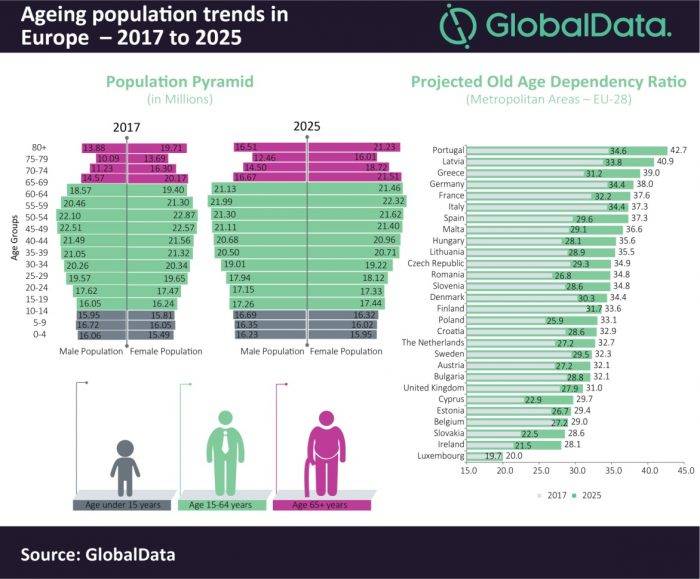March 27, 2018
Ageing population and low fertility rate is leading to European labour force shortage

Europe faces an increasing labour force shortage, which means that between 2017 and 2025, 184 out of 263 metropolitan areas from the EU-28 will record a negative growth rate in their working age population. According to a recent analysis by GlobalData this is due to a combination of lower fertility rates across most European Union (EU) countries, which is causing a reduction the growth rates of the youth population, while increased life expectancy is leading to a steady rise in the growth of the elderly population. But according to Ramnivas Mundada, Economic Research Analyst at GlobalData, ‘‘Measures such as increasing the levels of post-retirement employment opportunities, offering more support for women returning to the workplace and investing in youth employment, education and training could help to mitigate the impact of these demographic changes over the long term.’’
By 2025 more than one-fifth of the population in metropolitan cities from the EU-28 covered by the company’s analysis will be aged 65 years old and over. The old age dependency ratio, which measures the number of elderly people (population aged above 65), as a share of those of working age (population aged between 15 and 64), is projected to increase from 31.2 percent in 2017 to 35.3 percent by 2025 across the EU-28 cities, due to the increase in life expectancy and a shrinking working age population. Between 2017 and 2025 Neubrandenburg (Germany) and Galati (Romania) are projected to register the maximum change in the old age dependency ratio of all EU-28 cities of 14.6 percent and 13.2 percent respectively.
Ramnivas Mundada continued, “The populations of most European cities are currently undergoing significant demographic changes, which are projected to completely transform their economic and social landscape. We predict that between 2017 and 2025, 184 out of 263 metropolitan areas from the EU-28 will record a negative growth rate in their working age population.
‘‘Most of these cities belong to Germany, the United Kingdom, Spain, Poland, France and Romania. Riga (Latvia) and Galati (Romania) are both expected to register the sharpest declines in their working age population during this period with a compound annual growth rate (CAGR) of only 2.2 percent and 1.7 percent respectively.’’

Ramnivas added, ‘‘The changing nature of the age structure we are seeing here is expected to increase the burden on the income earning population and could have an adverse impact on the economic growth prospects of EU-28 cities. Furthermore, it could also place pressure on public finances as healthcare expenditure and public pension provision costs rise.”












